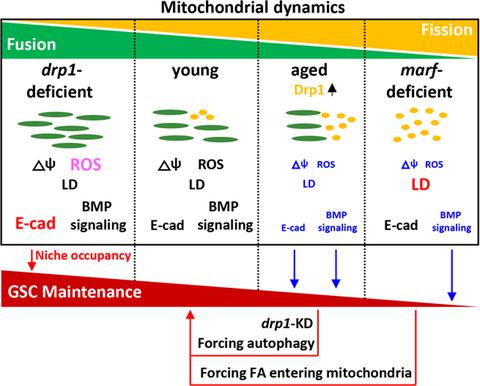当前位置:
X-MOL 学术
›
Aging Cell
›
论文详情
Our official English website, www.x-mol.net, welcomes your feedback! (Note: you will need to create a separate account there.)
Aging shifts mitochondrial dynamics toward fission to promote germline stem cell loss.
Aging Cell ( IF 7.8 ) Pub Date : 2020-07-14 , DOI: 10.1111/acel.13191 Oyundari Amartuvshin,Chi-Hung Lin,Shao-Chun Hsu,Shih-Han Kao,Alvin Chen,Wei-Chun Tang,Han-Lin Chou,Dong-Lin Chang,Yen-Yang Hsu,Bai-Shiou Hsiao,Elham Rastegari,Kun-Yang Lin,Yu-Ting Wang,Chi-Kuang Yao,Guang-Chao Chen,Bi-Chang Chen,Hwei-Jan Hsu
Aging Cell ( IF 7.8 ) Pub Date : 2020-07-14 , DOI: 10.1111/acel.13191 Oyundari Amartuvshin,Chi-Hung Lin,Shao-Chun Hsu,Shih-Han Kao,Alvin Chen,Wei-Chun Tang,Han-Lin Chou,Dong-Lin Chang,Yen-Yang Hsu,Bai-Shiou Hsiao,Elham Rastegari,Kun-Yang Lin,Yu-Ting Wang,Chi-Kuang Yao,Guang-Chao Chen,Bi-Chang Chen,Hwei-Jan Hsu

|
Changes in mitochondrial dynamics (fusion and fission) are known to occur during stem cell differentiation; however, the role of this phenomenon in tissue aging remains unclear. Here, we report that mitochondrial dynamics are shifted toward fission during aging of Drosophila ovarian germline stem cells (GSCs), and this shift contributes to aging‐related GSC loss. We found that as GSCs age, mitochondrial fragmentation and expression of the mitochondrial fission regulator, Dynamin‐related protein (Drp1), are both increased, while mitochondrial membrane potential is reduced. Moreover, preventing mitochondrial fusion in GSCs results in highly fragmented depolarized mitochondria, decreased BMP stemness signaling, impaired fatty acid metabolism, and GSC loss. Conversely, forcing mitochondrial elongation promotes GSC attachment to the niche. Importantly, maintenance of aging GSCs can be enhanced by suppressing Drp1 expression to prevent mitochondrial fission or treating with rapamycin, which is known to promote autophagy via TOR inhibition. Overall, our results show that mitochondrial dynamics are altered during physiological aging, affecting stem cell homeostasis via coordinated changes in stemness signaling, niche contact, and cellular metabolism. Such effects may also be highly relevant to other stem cell types and aging‐induced tissue degeneration.
中文翻译:

衰老使线粒体动力学转向裂变,从而促进生殖干细胞损失。
众所周知,干细胞分化过程中会发生线粒体动力学的变化(融合和裂变);然而,这种现象在组织衰老中的作用仍不清楚。在这里,我们报告说,在果蝇卵巢生殖干细胞(GSC)衰老过程中,线粒体动力学向裂变方向转变,这种转变导致与衰老相关的 GSC 损失。我们发现,随着 GSC 年龄的增长,线粒体碎片和线粒体裂变调节因子 Dynamin 相关蛋白 (Drp1) 的表达均增加,而线粒体膜电位降低。此外,阻止 GSC 中的线粒体融合会导致线粒体去极化高度碎片化、BMP 干性信号减弱、脂肪酸代谢受损和 GSC 丢失。相反,强迫线粒体伸长会促进 GSC 附着在生态位上。重要的是,通过抑制 Drp1 表达以防止线粒体裂变或用雷帕霉素治疗(已知雷帕霉素可通过 TOR 抑制促进自噬),可以增强衰老 GSC 的维持。总体而言,我们的结果表明,线粒体动力学在生理衰老过程中发生改变,通过干性信号传导、生态位接触和细胞代谢的协调变化影响干细胞稳态。这种效应也可能与其他干细胞类型和衰老引起的组织退化高度相关。
更新日期:2020-07-14
中文翻译:

衰老使线粒体动力学转向裂变,从而促进生殖干细胞损失。
众所周知,干细胞分化过程中会发生线粒体动力学的变化(融合和裂变);然而,这种现象在组织衰老中的作用仍不清楚。在这里,我们报告说,在果蝇卵巢生殖干细胞(GSC)衰老过程中,线粒体动力学向裂变方向转变,这种转变导致与衰老相关的 GSC 损失。我们发现,随着 GSC 年龄的增长,线粒体碎片和线粒体裂变调节因子 Dynamin 相关蛋白 (Drp1) 的表达均增加,而线粒体膜电位降低。此外,阻止 GSC 中的线粒体融合会导致线粒体去极化高度碎片化、BMP 干性信号减弱、脂肪酸代谢受损和 GSC 丢失。相反,强迫线粒体伸长会促进 GSC 附着在生态位上。重要的是,通过抑制 Drp1 表达以防止线粒体裂变或用雷帕霉素治疗(已知雷帕霉素可通过 TOR 抑制促进自噬),可以增强衰老 GSC 的维持。总体而言,我们的结果表明,线粒体动力学在生理衰老过程中发生改变,通过干性信号传导、生态位接触和细胞代谢的协调变化影响干细胞稳态。这种效应也可能与其他干细胞类型和衰老引起的组织退化高度相关。


























 京公网安备 11010802027423号
京公网安备 11010802027423号